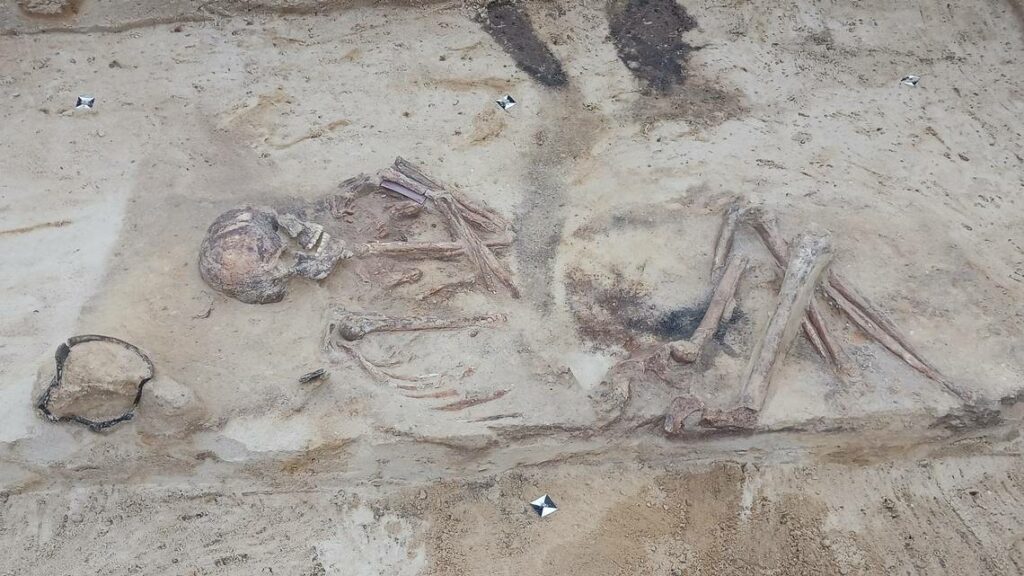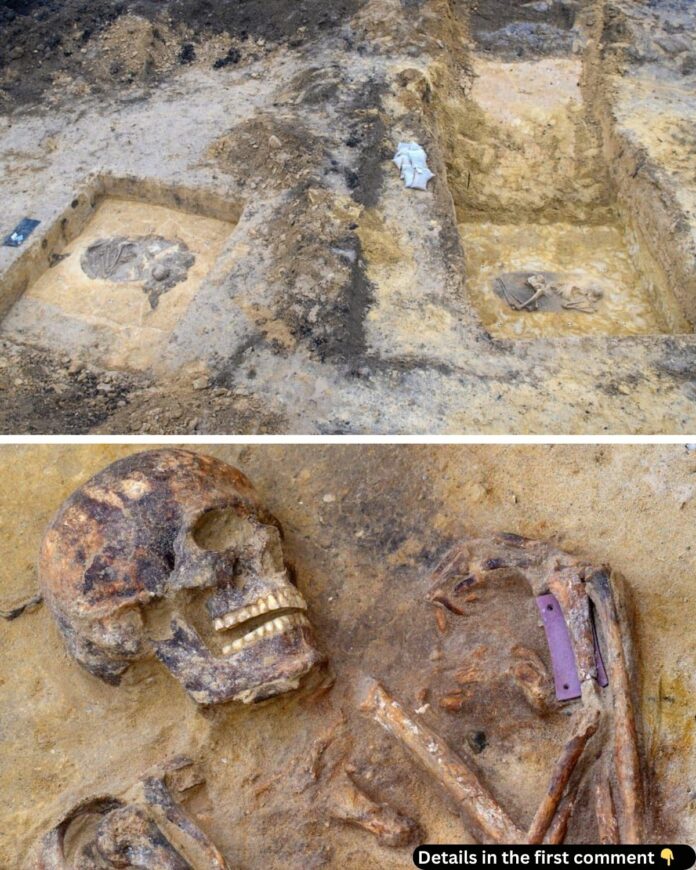In an extraordinary archaeological revelation, construction workers extending Germany’s SuedOstLink power line made an unexpected discovery that has captivated historians worldwide. Three exceptionally preserved warrior graves dating back 4,500 years were unearthed, offering a rare window into Europe’s ancient past and the enigmatic Bell Beaker culture.
The Remarkable Discovery
During routine excavations near Förderstedt, archaeologists uncovered a burial site containing ten graves, with three standing out for their exceptional preservation and significance. These graves belonged to warriors of the Bell Beaker culture, a civilization that flourished across Europe during the transition from the late Neolithic to early Bronze Age periods.

What makes this discovery particularly remarkable is the preservation of one warrior still wearing his stone arm guard – a protective piece of equipment used by archers to shield their wrists from bowstring recoil. In another grave, archaeologists found two arrowheads alongside the faint impression of what once was a quiver, painting a vivid picture of these individuals’ roles in their society.
Bell Beaker Warriors: Elite Protectors of Their Community
The warriors were buried in a communal mound, suggesting they held elevated status within their society. Each body was positioned in the traditional Bell Beaker manner – in a crouched position facing east, with men placed on their left sides, a practice that distinguished them from female burials typically positioned on the right side.

“These positioning practices weren’t random,” explains Christian Lau, the excavation leader. “They reflected deep cultural beliefs about life, death, and the journey to the afterlife.”
Artifacts That Tell a Story
Weapons and Pottery: Symbols of Status and Belief
Among the most significant finds was the stone arm guard measuring approximately 8 by 4 centimeters. This protective equipment not only identifies its wearer as an archer but also symbolizes their role as a warrior and protector.

The distinctive bell-shaped pottery vessel found in one grave – measuring about 15 centimeters in diameter – represents the hallmark of this ancient culture. These vessels typically contained food offerings for the deceased’s journey into the afterlife, reflecting beliefs in an existence beyond death that required nourishment and provisions.
Nature’s Preservation: The Role of Loess Clay
The exceptional preservation of these 4,500-year-old remains can be attributed to the unique properties of the local loess clay. The graves were deliberately dug down to this clay layer and then filled with unmixed clay, creating an environment that protected both bones and artifacts from deterioration over millennia.
“If these graves had been placed in sandy soil instead,” Lau noted, “we would have lost most of this invaluable historical evidence.”
Beyond Burial: Understanding an Ancient Society
Warriors in Context: Life in the Bell Beaker Period
The Bell Beaker people, named for their distinctive pottery, were known for their advanced farming techniques, metalworking skills, and extensive trade networks. While much about their daily lives remains mysterious, these graves provide crucial insights into their social structures and community organization.

The presence of warrior graves with specialized equipment suggests a society that valued protection and possibly faced regular conflicts. The shared burial mound indicates these individuals may have belonged to an elite warrior class that held significant status within their community.
Video
Modern Development Reveals Ancient History
This discovery highlights the unexpected benefits that can emerge from modern infrastructure projects. While the power line expansion was never intended as an archaeological endeavor, it has provided an invaluable opportunity to study an ancient burial site and learn more about European prehistory.
Ongoing Research and Future Insights
Archaeologists will continue studying these remains and artifacts using modern analytical techniques. By examining the bones, researchers hope to learn more about these warriors’ health, diet, and lifestyle. The weapons and grave goods will provide further information about technology and warfare practices of the period.

As this research progresses, we can expect to develop a more comprehensive understanding of the Bell Beaker culture and their role in shaping early European civilization. These silent warriors, though separated from us by 4,500 years, continue to speak through their carefully preserved remains, sharing stories of a world long past but increasingly understood.

